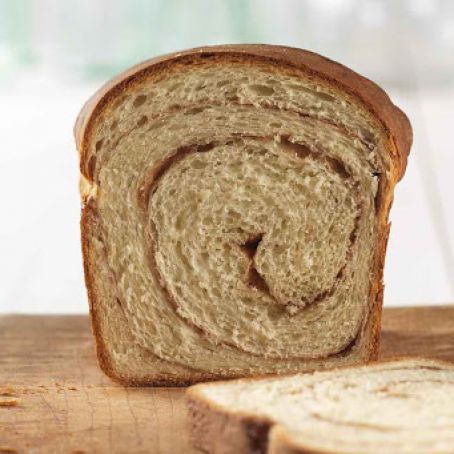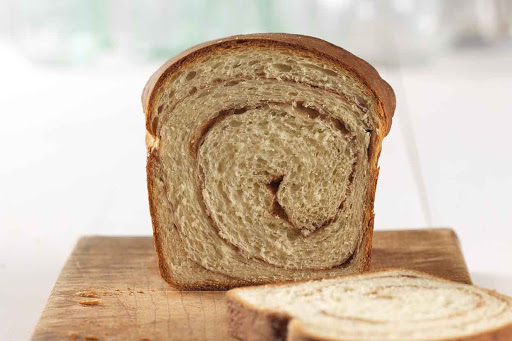KAF Cinnamon Swirl Bread
By á-94276
 1 Picture
1 Picture
Ingredients
- dough
- 1/4-ounce packet "highly active" active dry yeast; or 2 1/2 teaspoons active dry yeast; or 2 1/2 teaspoons instant yeast
- 7/8 to 1 1/8 cups lukewarm water*
- 3 cups King Arthur Unbleached All-Purpose Flour
- 1 1/4 teaspoons salt
- 3 tablespoons sugar
- 6 tablespoons unsalted butter, at room temperature
- 1/4 cup nonfat dry milk
- 1/2 cup instant mashed potato flakes
- Use the lesser amount in summer (or in a humid environment), the greater amount in winter (or in a dry climate), and somewhere in between the rest of the year, or if your house is climate controlled.
- filling
- 1/4 cup granulated sugar
- 1 1/2 teaspoons ground cinnamon
- 2 teaspoons King Arthur Unbleached All-Purpose Flour
- 1 large egg beaten with 1 tablespoon water, to brush on dough
Details
Adapted from kingarthurflour.com
Preparation
Step 1
1) If you're using "highly active" or active dry yeast, dissolve it with a pinch of sugar in 2 tablespoons of the lukewarm water. Let the yeast and water sit at room temperature for 15 minutes, until the mixture has bubbled and expanded. If you're using instant yeast, you can skip this step.
2) Combine the dissolved yeast (or instant yeast) with the remainder of the ingredients. Mix and knead everything together—by hand, mixer or bread machine set on the dough cycle—till you've made a smooth dough. Adjust the dough's consistency with additional flour or water as needed; but remember, the more flour you add while you're kneading, the heavier and drier your final loaf will be. If you're kneading in a stand mixer, it should take about 7 minutes at second speed, and the dough should barely clean the sides of the bowl, perhaps sticking a bit at the bottom. In a bread machine (or by hand), it should form a smooth ball.
3) Place the dough in a lightly greased bowl. Cover the bowl, and allow the dough to rise, at room temperature, until it's nearly doubled in bulk, about 1 hour. Rising may take longer, especially if you've kneaded by hand. Give it enough time to become quite puffy.
4) While the dough is rising, make the filling by stirring together the sugar, cinnamon, and flour.
5) Transfer the dough to a lightly greased work surface, and pat it into a 6" x 20" rectangle.
6) Brush the dough with the egg/water mixture, and sprinkle it evenly with the filling.
7) Starting with a short end, roll the dough into a log.
8) Pinch the ends to seal, and pinch the long seam closed.
9) Transfer the log, seam-side down, to a lightly greased 8 1/2" x 4 1/2" loaf pan. Tent the pan loosely with lightly greased plastic wrap.
10) Allow the bread to rise till it's crested about 1" over the rim of the pan, about 1 hour. Again, it may rise more slowly for you; let it rise till it's 1" over the rim of the pan, even if that takes longer than an hour. While the dough is rising, preheat the oven to 350°F.
11) Bake the bread for 40 to 45 minutes, tenting it lightly with aluminum foil after the first 15 minutes. The bread's crust will be golden brown, and the interior of the finished loaf should measure 190°F on an instant-read thermometer.
12) Remove the bread from the oven, and gently loosen the edges with a heatproof spatula or table knife. Turn it out of the pan, and brush the top surface with butter, if desired; this will give it a soft, satiny crust. Allow the bread to cool completely before slicing.
Tips from our bakers:
When making yeast bread, let the dough rise to the point the recipe says it should, e.g., "Let the dough rise till it's doubled in bulk." Rising times are only a guide; there are so many variables in yeast baking that it's impossible to say that bread dough will ALWAYS double in bulk in a specific amount of time.
Don't skip the step of brushing the dough with the egg/water wash before sprinkling on the filling. The egg is what keeps the bread from "gapping" around the filling.
If you bake this bread in a 9" x 5" loaf pan, it'll be flatter and not as nicely domed. It will have risen to about even with the rim of the pan when it's ready to go into the oven.

Review this recipe